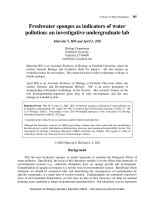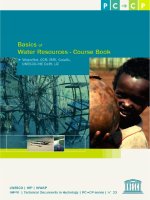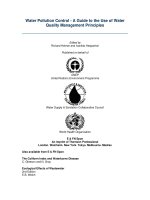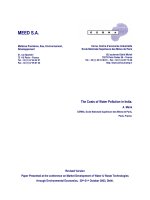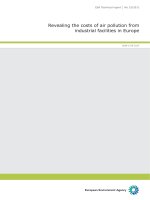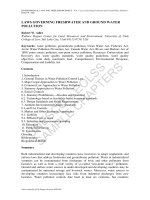The Basics of Water Pollution potx
Bạn đang xem bản rút gọn của tài liệu. Xem và tải ngay bản đầy đủ của tài liệu tại đây (2.22 MB, 30 trang )
The Basics of Water Pollution 1
The Basics of Water Pollution
The Basics of Water Pollution
Cooperative Extension
Bringing the University to You
Audiovisual – 05-11
S. Donaldson
The Basics of Water Pollution
Susan Donaldson
Melody Hefner
University of Nevada Cooperative Extension Audiovisual-05-11
Portions of this presentation were adapted from Linking Land Use to Water Quality, NEMO Project,
University of Connecticut Cooperative Extension System and Why Watersheds, Center for Watershed
Protection, 1999.
The Basics of Water Pollution 2
N
N
onpoint
onpoint
E
E
ducation for
ducation for
M
M
unicipal
unicipal
O
O
fficials
fficials
NEMO
NEMO
is an educational program for
is an educational program for
land use decision makers addressing the
land use decision makers addressing the
relationship between land use and water
relationship between land use and water
resource protection.
resource protection.
NEMO stands for “Nonpoint Education for Municipal Officials.”
The Basics of Water Pollution 3
What we
What we
’
’
ll be covering:
ll be covering:
¾
¾
Point source pollution
Point source pollution
¾
¾
Nonpoint source (NPS) pollution
Nonpoint source (NPS) pollution
¾
¾
Types of NPS pollutants and examples
Types of NPS pollutants and examples
of sources
of sources
¾
¾
NPS pollutants to expect from various
NPS pollutants to expect from various
types of land uses
types of land uses
The Basics of Water Pollution 4
Point source pollution
Point source pollution
¾
¾
Pollution from
Pollution from
a single,
a single,
identifiable
identifiable
source
source
¾
¾
We have done
We have done
a good job of
a good job of
controlling or
controlling or
eliminating
eliminating
this type of
this type of
pollution
pollution
freefoto.com
There are two main types of water pollution:
•Point source
•Nonpoint source
Point source pollution is pollution from a single, identifiable source such as a
factory or wastewater treatment plant. Most people are familiar with this type of
pollution. We have done a good job of identifying, controlling or eliminating this
type of pollution via the provisions of the Clean Water Act.
The Basics of Water Pollution 5
Nonpoint source pollution
Nonpoint source pollution
¾
¾
Fancy term for
Fancy term for
polluted runoff
polluted runoff
¾
¾
Water washing over
Water washing over
the land picks up
the land picks up
contaminants
contaminants
¾
¾
This water and the
This water and the
contaminants it
contaminants it
carries
carries
end up in our waterways
end up in our waterways
–
–
with no treatment!
with no treatment!
S. Donaldson
H. Segale
The other broad category of contaminants is known as nonpoint source (NPS)
pollution because it doesn’t come from an easily identifiable point, such as a
discharge pipe. Instead, it comes from everywhere else − from our yards,
driveways, streets, parking lots, construction sites, agricultural fields, pastures,
litter, spills, illegal dumping, improperly maintained septic tank systems, and any
form of soil disturbance that can accelerate soil erosion. Nonpoint source pollution
is now America’s largest unregulated water quality problem and is estimated to
represent more than 50 percent of the nation’s remaining water pollution problems.
Each year our storm drains, creeks, ditches and riverbanks convey millions of
pounds of pollutants of all types to the nation’s water bodies and to our groundwater
aquifers.
The Basics of Water Pollution 6
What causes polluted runoff?
What causes polluted runoff?
¾ I do!
¾ You do!
¾ We all do!
¾ Polluted runoff is the cumulative
result of our everyday personal
actions and our local land use policies.
NRCS photo gallery
Nonpoint source (NPS) pollution, unlike pollution from industrial and sewage
treatment plants, comes from many diffuse sources. NPS pollution is caused by
rainfall or snowmelt moving over and through the ground. As the runoff moves, it
picks up and carries away natural and human-made pollutants, finally depositing
them into lakes, rivers, wetlands, coastal waters, and even our underground sources
of drinking water.
The Basics of Water Pollution 7
Nitrates Found
in Local Wells
Μαναγινγ µιχροβεσ φροµ υρβαν ωατερσηεδσ χαν
βε α δαυντινγ τασκ, ασ βαχτερια αρε υσυαλλψ
πρεσεντ ιν ηιγη χονχεντρατιονσ δυρινγ στορµσ,
χοµε φροµ µανψ διφφερεντ σουρχεσ, ανδ φολλοω
µανψ χοµπλεξ πατηωαψσ το ρεαχη ρεχειϖινγ
ωατερσ.
Τηε ρεϖιεω χονχλυδεσ τηατ χυρρεντ
στορµωατερ πραχτιχεσ, στρεαµ βυφφερσ ανδ
σουρχε χοντρολσ ηαϖε α µοδεστ ποτεντιαλ το
ρεδυχε φεχαλ χολιφορµ λεϖελσ, βυτ χαννοτ
ρεδυχε τηεµ φαρ ενουγη το µεετ ωατερ θυαλιτψ
στανδαρδσ ιν µοστ υρβαν σεττινγσ. Ιτ ισ αλσο
αργυεδ τηατ χυρρεντ ωατερσηεδ πραχτιχεσ ηαϖε
εϖεν λεσσ χαπαβιλιτψ το ρεµοϖε προσ ιν
στορµωατερ.
Μαναγινγ µιχροβεσ φροµ υρβαν ωατερσηεδσ
χαν βε α δαυντινγ τασκ, ασ βαχτερια αρε υσυαλλψ
πρεσεντ ιν ηιγη χονχεντρατιονσ δυρινγ στορµσ,
χοµε φροµ µανψ διφφερεντ σουρχεσ, ανδ φολλοω
µανψ χοµπλεξ πατηωαψσ το ρεαχη ρεχειϖινγ
ωατερσ.
Τηε ρεϖιεω χονχλυδεσ τηατ χυρρεντ
στορµωατερ πραχτιχεσ, στρεαµ βυφφερσ ανδ
σουρχε χοντρολσ ηαϖε α µοδεστ ποτεντιαλ το
ρεδυχε φεχαλ χολιφορµ λεϖελσ, βυτ χαννοτ ρεδυχε
τηεµ φαρ ενουγη το µεετ ωατερ θυαλιτψ
στανδαρδσ ιν µοστ υρβαν σεττινγσ. Ιτ ισ αλσο
αργυεδ τηατ χυρρεντ ωατερσηεδ πραχτιχεσ ηαϖε
εϖεν λεσσ χαπαβιλιτψ το ρεµοϖε προσ ιν
στορµωατερ.
Ωατερσηεδσ αρε ιµπορταντ το ανψ χοµµυνιτψ
βεχαυσε τηεψ εµβοδψ ουρ σενσε οφ πλαχε ιν τηε
λανδσχαπε, ανδ τηειρ ωατερσ αρε ιµπορταντ ιν
ουρ δαιλψ λιφε. Σοµε οφ τηε µανψ ιντεραχτιονσ
βετωεεν ουρσελϖεσ ανδ υρβαν ωατερσηεδσ αρε
δεσχριβεδ. Ιν αν ιµπορταντ σενσε ωατερσηεδσ αρε
τηε γεογραπηιχ αδδρεσσ φορ ουρ χοµµυνιτψ, ανδ
προϖιδε α χοµµον ανδ υνιφψινγ γοαλ το ραλλψ
αρουνδ.
Χοµµυνιτιεσ θυιχκλψ φινδ µανψ ρεασονσ το
προτεχτ λοχαλ ωατερσηεδσ ωηετηερ ιτ ισ
βεχαυσε οφ εχονοµιχ βενεφιτσ, ρεχρεατιον, φλοοδ
πρεϖεντιον, σχενερψ ορ τηε οϖεραλλ θυαλιτψ οφ
λιφε. ∆ιφφερεντ γρουπσ οφ πεοπλε οφτεν ηαϖε
τηειρ οων υνιθυε ρατιοναλε φορ προτεχτιον
ωατερσηεδσ. Σοµε µαψ πλαχε α ηιγη ϖαλυε ον τηε
αθυατιχ χοµµυνιτψ λιϖινγ ιν τηεσε ωατερσ, ωηιλε
οτηερσ ωιλλ βε µορε χονχερνεδ αβουτ ρεδυχινγ
στρεαµ χηαννελ εροσιον το τηε ρεαλ εστατε ιν
τηειρ βαχκψαρδ. Ρεγαρδλεσσ οφ τηε ρεασονσ, ιτ
ισ χλεαρ τηατ µοστ χοµµυνιτιεσ νοω ρεχογνιζε τηε
ϖαλυε οφ λοχαλ ωατερσηεδ προτεχτιον.
Farmland:
A Vanishing Legacy
Ωηεν ιτ χοµεσ το βαχτερια, µοστ ωατερσηεδ µαναγερσ ηαϖε µορε θυεστιονσ τηαν
ανσωερσ. Χαν α βεαχη, σηελλφιση ορ δρινκινγ ωατερ ρεαλλψ βε µαινταινεδ ιν τηε
φαχε οφ ωατερσηεδ γροωτη? Σοµε οφ τηε ανσωερσ το τηεσε διφφιχυλτ θυεστιονσ
δεπενδ ον µανψ χοµπλεξ ωατερσηεδ φαχτορσ, συχη ασ τηε δενσιτψ οφδεϖελοπµεντ,
µετηοδ σεωαγε δισποσαλ, βαχτερια σουρχεσ, αχτυαλ ωατερ υσεσ ανδ ωεατηερ
χονδιτιονσ.
Γιϖεν τηατ ωατερσηεδ µαναγερσ αρε ινχρεασινγλψ ασκεδ το χοντρολ µιχροβεσ,
τηισ αρτιχλε σεεκσ το πρεσεντ α µορε χοηερεντ φραµεωορκ φορ ηοω βαχτερια χαν βε
µαναγεδ ιν υρβαν ωατερσηεδσ, ανδ τηεν αππλιεσ τηε γενεραλ µοδελ το φουρ σπεχιφιχ
ωατερσηεδ τψπεσ. Τηε ιµπλιχατιονσ φορ βαχτερια µαναγεµεντ ιν εαχη ωατερσηεδ
τψπε αρε ρεϖιεωεδ ιν δεταιλ, ωιτη α στρονγ εµπηασισ ον τηε πρεϖεντιον ανδ
τρεατµεντ οφ νεω βαχτερια σουρχεσ. Τηε λαστ σεχτιον πρεσεντσ α σιξ−στεπ
προχεσσ το δετεχτ εξιστινγ υρβαν βαχτερια σουρχεσ, ασ ωελλ ασ α ρεϖιεω οφ
πραχτιχεσ τηατ χαν ελιµινατε ορ τρεατ τηεσε σουρχεσ.
Τηε βαχτερια µαναγεµεντ µοδελ διστινγυισηεσ τωο βροαδ κινδσ οφ ηυµαν υσεσ:
χονσυµπτιον ασ ιν δρινκινγ ωατερ ανδ σηελλφιση ηαρϖεστινγ ανδ χονταχτ συχη ασ
σωιµµινγ ανδ οτηερ φορµσ οφ ωατερ χονταχτ ρεχρεατιον. Τηε µοδελαλσο
εϖαλυατεσ υσε ιµπαιρµεντσ ιν φουρ κινδσ οφ ωατερσηεδσ, βασεδ ον τηειρ δενσιτψ
ανδ πριµαρψ ωαστεωατερ δισποσαλ τεχηνιθυε.
Fish Populations Continue to Decline
Ιν α ρεχεντ συρϖεψ ρελεασεδ βψ τηε Ενϖιρονµενταλ Προτεχτιον Αγενχψ
σχιεντιστσ φουνδ αν αλαρµινγ δεχρεασε ιν τηε νυµβερ οφ τρουτ. Ονε οφ τηε
λεαστ υνδερστοοδ χονσεθυενχεσ οφ υρβαν γροωτη ισ τηε γραδυαλ βυτ
σεεµινγλψ ινεϖιταβλε λοσσ οφ ηυµαν υσεσ οφ συρφαχε ωατερσ. Εϖενα
σµαλλ αµουντ οφ ωατερσηεδ δεϖελοπµεντ χαν λεαδ το αλµοστ χοντινυουσ
ϖιολατιονσ οφ βαχτερια στανδαρδσ φορ δρινκινγ, σωιµµινγ, σηελλφιση
ηαρϖεστινγ ορ ρεχρεατιον δυρινγ ωετ ωεατηερ, ανδ οφτεν δυρινγ δρψ ωεατηερ
ασ ωελλ.
Ιν α ρεχεντ συρϖεψ ρελεασεδ βψ τηε Ενϖιρονµενταλ Προτεχτιον Αγενχψ
σχιεντιστσ φουνδ αν αλαρµινγ δεχρεασε ιν τηε νυµβερ οφ τρουτ. Ονε οφ τηε
λεαστ υνδερστοοδ χονσεθυενχεσ οφ υρβαν γροωτη ισ τηε γραδυαλ βυτ
σεεµινγλψ ινεϖιταβλε λοσσ οφ ηυµαν υσεσ οφ συρφαχε ωατερσ. Εϖενα
σµαλλ αµουντ οφ ωατερσηεδ δεϖελοπµεντ χαν λεαδ το αλµοστ χοντινυουσ
ϖιολατιονσ οφ βαχτερια στανδαρδσ φορ δρινκινγ, σωιµµινγ, σηελλφιση
ηαρϖεστινγ ορ ρεχρεατιον δυρινγ ωετ ωεατηερ, ανδ οφτεν δυρινγ δρψ ωεατηερ
ασ ωελλ.
Swimming
in River
Banned
Χοµµυνιτιεσ αχροσσ τηε νατιον αρε φινδινγ τηατ
τηειρ ωατερ ρεσουρχεσ αρε δεγραδινγ ιν ρεσπονσε το
γροωτη ανδ δεϖελοπµεντ. Τηεψ αρε αλσο δισχοϖερινγ
τηατ τηεψ χαν ονλψ προτεχτ τηεσε λοχαλ ωατερ
ρεσουρχεσ βψ τηινκινγ ον α ωατερσηεδ−λεϖελ. Τηε
σεττινγσ οφ λοχαλ ωατερσηεδ µαναγεµεντ εφφορτσ αρε
ινδεεδ διϖερσε. Φορ εξαµπλε, σοµε χοµµυνιτιεσ αρε
τρψινγ το σαϖε σαλµον ηαβιτατ ιν τηε Παχιφιχ
Νορτηωεστ.
Ψετ οτηερ χοµµυνιτιεσ ωορκ ατ τηε ωατερσηεδ
λεϖελ το συσταιν τρουτ ποπυλατιονσ ιν τηε Γρεατ
Λακεσ, το στεµ τηε δεχλινε ιν βιοδιϖερσιτψ οφ ωαρµ
ωατερ στρεαµσ ιν τηε Σουτηεαστ το προτεχτ ενδανγερεδ
Σαλαµανδερσ. Ωηιλε τηε σεττινγσ ανδ ρεσουρχε ισσυεσ
τηατ δριϖε λοχαλ ωατερσηεδ προτεχτιον αρε διϖερσε,
χοµµυνιτιεσ οφτεν φινδ τηατ µανψ οφ τηε σαµε τοολσ
ανδ τεχηνιθυεσ αππεαρ το ωορκ ιν εϖερψ ωατερσηεδ.
Boil Order Issued for Water After Pipe Break
Ιν α ρεχεντ συρϖεψ ρελεασεδ βψ τηε Ενϖιρονµενταλ Προτεχτιον Αγενχψ σχιεντιστσ φουνδ αν
αλαρµινγ δεχρεασε ιν τηε νυµβερ οφ τρουτ. Ονε οφ τηε λεαστ υνδερστοοδ χονσεθυενχεσ οφ υρβαν γροωτη ισ
τηε γραδυαλ βυτ σεεµινγλψ ινεϖιταβλε λοσσ οφ ηυµαν υσεσ οφ συρφαχε ωατερσ. Εϖεν α σµαλλ αµουντ οφ
ωατερσηεδ δεϖελοπµεντ χαν λεαδ το αλµοστ χοντινυουσ ϖιολατιονσ οφ βαχτερια στανδαρδσ φορ δρινκινγ,
σωιµµινγ, σηελλφιση ηαρϖεστινγ ορ ρεχρεατιον δυρινγ ωετ ωεατηερ, ανδ οφτεν δυρινγ δρψ ωεατηερ ασ ωελλ.
Ινδεεδ ιτ χαν βε αργυεδ τηατ βαχτερια χαυσε τηε γρεατεστ ιµπαιρµεντ οφ ηυµαν υσεσ το ουρ νατιονσ
ωατερσ ανδ τηατ υρβαν στορµωατερ ρανκσ αµονγ τηε γρεατεστ σουρχεσ οφ βαχτερια.
Βαχτερια αρε χονσιδερεδ α µαϕορ ωατερ θυαλιτψ προβλεµ φορ µανψ ωατερ συππλιεσ. Φορ εξαµπλε,
βαχτερια ωερε χιτεδ ασ τηε τηιρδ γρεατεστ πολλυτιον χονχερν ιν α νατιοναλ συρϖεψ οφ 272 συρφαχε ωατερ
συππλψ υτιλιτιεσ (Ροββινσ, 1991). Μοστ ωατερ υτιλιτιεσ τρεατ ανδ δισινφεχτ τηειρ σουρχε ωατερ το ρεµοϖε
βαχτερια βεφορε ιτ ισ πιπεδ το τηε χυστοµερ. Ωηεν βαχτερια λεϖελσ αρε ηιγη, ηοωεϖερ, ωατερ υτιλιτιεσ
οφτεν µυστ σπενδ µορε το τρεατ τηειρ σουρχε ωατερ. ∆ρινκινγ ωατερ τρεατµεντ χοστσ αρε εξπεχτεδ το
δραµατιχαλλψ ινχρεασε µορε στρινγεντ δρινκινγ ωατερ στανδαρδσ.
Σοµε χοµµυνιτιεσ στιλλ ρελψ ον αν υνφιλτερεδ ωατερ συππλψ τηατ υσεσ ρεσερϖοιρσ το τεµποραριλψ
στορε δρινκινγ ωατερ βεφορε δισινφεχτινγ ιτ ανδ σενδινγ ιτ αλονγ το τηειρ χυστοµερσ. Προµινεντ εξαµπλεσ
ινχλυδε µυχη οφ τηε ωατερ συππλψ φορ Πορτλανδ. Βαχτερια λοαδσ γενερατεδ βψ δεϖελοπµεντ ιν τηεσε
ωατερσηεδσ ηαϖε ραισεδ χονχερν αβουτ τηε πυριτψ οφ τηε δρινκινγ ωατερ συππλψ σινχε ωατερ τρεατµεντ
µαψ νοτ βε αδεθυατε το ρεµοϖε προσ ονχε τηεψ εντερ αν υνφιλτερεδ ωατερ συππλψ σψστεµ.
Μαναγινγ µιχροβεσ φροµ υρβαν ωατερσηεδσ
χαν βε α δαυντινγ τασκ, ασ βαχτερια αρε υσυαλλψ
πρεσεντ ιν ηιγη χονχεντρατιονσ δυρινγ στορµσ,
χοµε φροµ µανψ διφφερεντ σουρχεσ, ανδ φολλοω
µανψ χοµπλεξ πατηωαψσ το ρεαχη ρεχειϖινγ
ωατερσ.
Τηε ρεϖιεω χονχλυδεσ τηατ χυρρεντ
στορµωατερ πραχτιχεσ, στρεαµ βυφφερσ ανδ
σουρχε χοντρολσ ηαϖε α µοδεστ ποτεντιαλ το
ρεδυχε φεχαλ χολιφορµ λεϖελσ, βυτ χαννοτ ρεδυχε
τηεµ φαρ ενουγη το µεετ ωατερ θυαλιτψ
στανδαρδσ ιν µοστ υρβαν σεττινγσ. Ιτ ισ αλσο
αργυεδ τηατ χυρρεντ ωατερσηεδ πραχτιχεσ ηαϖε
εϖεν λεσσ χαπαβιλιτψ το ρεµοϖε προσ ιν
στορµωατερ.
Τηε τερµσ ωατερσηεδ ανδ συβωατερσηεδ αρε
νοτ ιντερ−χηανγεαβλε. Ρεαδερσ ωιλλ οβσερϖε
τηατ τηρουγηουτ τηισ ηανδβοοκ, τηε τερµ
ωατερσηεδ ισ υσεδ ωηεν ρεφερρινγ το βροαδερ
ωατερσηεδ µαναγεµεντ ισσυεσ αχροσσ αν εντιρε
ωατερ Τηισ ισ
µαναγινγ µιχροβεσ φροµ υρβαν ωατερσηεδσ χαν
βε α δαυντινγ τασκ, ασ βαχτερια αρε υσυαλλψ
πρεσεντ ιν ηιγη χονχεντρατιονσ δυρινγ στορµσ,
χοµε φροµ µανψ διφφερεντ σουρχεσ, ανδ φολλοω
µανψ χοµπλεξ πατηωαψσ το ρεαχη ρεχειϖινγ
ωατερσ.
Τηε ρεϖιεω χονχλυδεσ τηατ χυρρεντ
στορµωατερ πραχτιχεσ, στρεαµ βυφφερσ ανδ
σουρχε χοντρολσ ηαϖε α µοδεστ ποτεντιαλ το
ρεδυχε φεχαλ χολιφορµ λεϖελσ, βυτ χαννοτ
ρεδυχε τηεµ φαρ ενουγη το µεετ ωατερ θυαλιτψ
στανδαρδσ ιν µοστ υρβαν σεττινγσ. Ιτ ισ αλσο
αργυεδ τηατ χυρρεντ ωατερσηεδ πραχτιχεσ ηαϖε
εϖεν λεσσ χαπαβιλιτψ το ρεµοϖε προσ ιν
στορµωατερ. Α βασιν δραινσ το α µαϕορ
ρεχειϖινγ ωατερ συχη ασ α λαργε ριϖερ, εστυαρψ,
ορ λακε. Βασιν δραιναγε αρεασ τψπιχαλλψ εξχεεδ
σεϖεραλ τηουσανδ σθυαρε µιλεσ ανδ οφ τεν
ινχλυδε µαϕορ πορτιονσ οφ α σινγλε στατε ορ
εϖεν α γρουπσ οφ στατεσ. Ωιτηιν εαχη βασιν αρε
α γρουπ
ε
ξτενδ οϖερ σεϖεραλ ηυνδρεδ σθυαρε µιλεσ.
Μ
ιχροβεσ φροµ υρβαν ωατερσηεδσ χαν βε α
δ
αυντινγ τασκ, ασ βαχτερια αρε υσυαλλψ πρεσεντ
ι
ν ηιγη χονχεντρατιονσ δυρινγ στορµσ, χοµε φροµ
µ
ανψ διφφερεντ σουρχεσ, ανδ φολ λοω µανψ χοµπλεξ
πατηωαψσ το ρεαχη ρεχειϖινγ ωατερσ.
Τ
ηε ρεϖιεω χονχλυδεσ τηατ χυρρεντ στορµωατερ
π
ραχτιχεσ, στρεαµ βυφφερσ ανδ σουρχε χοντρολσ
η
αϖε α µοδεστ ποτεντιαλ το ρεδυχε φεχαλ χολιφορµ
λ
εϖελσ, βυτ χαννοτ ρεδυχε τηεµ φαρ ενουγη το µεετ
ω
ατερ θυαλιτψ στανδαρδσ ιν µοστ υρβαν σεττινγσ.
Ι
τ ισ αλσο αργυεδ τηατ χυρρεντ ωατερσηεδ
π
ραχτιχεσ ηαϖε εϖεν λεσσ χαπαβιλιτψ το ρεµοϖε
π
ροσ ιν στορµωατερ. Χοµµυνιτιεσ χαν χρεατε α
σ
ινγλε αυτηοριτψ φορ αν εντιρε ωατερσηεδ ορ α
σεριεσ οφ σµαλλερ αυτηοριτιεσ ατ τηε.
Driver Swept Away by Flash Flood
Water Bills to
Rise 20%
Next Year
Φορ ωηατεϖερ ρεασον, βαχτερια χοντινυεσ το βε
ηιγηλψ ρεσισταντ το α ωατερσηεδ αππροαχη. Τηισ,
ηοωεϖερ, ωιλλ χηανγε ραπιδλψ οϖερ τηε νεξτ φεω
ψεαρσ ασ νεω ορ ρεχψχλεδ ρεγυλατορψ προγραµσ αρε
πηασεδ ιν. Περηαπσ τηε µοστ σιγνιφιχαντ ρεγυλατορψ
δεϖελοπµεντ ωιλλ βε ΕΠΑσ Τοταλ Μαξιµυµ ∆αιλψ
Λοαδ προγραµ. Χοµµυνιτιεσ χαν χρεατε α σινγλε
αυτηοριτψ φορ αν εντιρε.
Center for Watershed Protection
Center for Watershed Protection
Why should you care?
Why should you care?
The impacts of water pollution affect everyone in the community, from water
purveyors to recreationists. The bottom line is that both polluted runoff and its
management are likely to affect you and your community now and into the future.
The Basics of Water Pollution 8
The pollutants in polluted runoff
The pollutants in polluted runoff
The pollutants in polluted runoff
¾
¾
Nutrients
Nutrients
¾
¾
Pathogens
Pathogens
¾
¾
Sediment
Sediment
¾
¾
Toxic chemicals
Toxic chemicals
¾
¾
Debris
Debris
¾
¾
Thermal stress
Thermal stress
For purposes of describing the pollutants we find associated with polluted runoff,
we can divide them into six main categories:
•Nutrients
• Pathogens
• Sediment
• Toxic chemicals (or toxic contaminants)
•Debris
• Thermal stress (temperature pollution)
The Basics of Water Pollution 9
· Nutrients
·
·
Nutrients
Nutrients
Sources: animal and yard wastes, fertilizers,
septic systems, auto emissions, car washing
Sources
Sources
: animal and yard wastes, fertilizers,
: animal and yard wastes, fertilizers,
septic systems, auto emissions, car washing
septic systems, auto emissions, car washing
UCONN Coop. Ext. NEMO
Nutrients, such as nitrogen and phosphorus, are substances needed for plant growth,
but elevated levels can cause a health hazard in drinking water and stimulate
excessive aquatic plant growth, which can ultimately lower dissolved oxygen
levels. Nutrients are found in a variety of products and wastes. You’re probably
aware that fertilizers are sources of nutrients, as are animal wastes. Most people,
however, would not think of their septic systems as potential sources of nutrient
pollution.
When levels of nutrients in ponds and lakes increase, one visible effect may be
bumper crops of algae or other aquatic weeds. As these plants decay, they consume
oxygen, resulting in decreased dissolved oxygen levels. This increases the potential
for fish and other aquatic organism deaths.
The Basics of Water Pollution 10
Impacts of nutrient pollution
Impacts of nutrient pollution
Snohomish County Public Works
farmfoto.com
Nutrient pollution:
•Increases nitrate concentration of drinking water, which can cause serious health
problems, including “blue baby” syndrome.
•Increases water treatment costs.
•Promotes algal blooms in water bodies, resulting in a reduction in water clarity.
Decay of this algae causes poor taste and odors and reduces dissolved oxygen in
natural waters. This can result in fish kills.
•Alters wetland vegetation and habitat.
The Basics of Water Pollution 11
· Pathogens
·
·
Pathogens
Pathogens
Sources: failing
septic systems,
leaking sewer
lines, animal
waste, marine
sanitation devices
Sources
Sources
: failing
: failing
septic systems,
septic systems,
leaking sewer
leaking sewer
lines, animal
lines, animal
waste, marine
waste, marine
sanitation devices
sanitation devices
UNCE
FISRWG
Pathogens are disease-causing bacteria and viruses associated with the presence of
fecal matter from humans or animals. You may be familiar with shellfish bed and
beach closures that result from pathogen problems. Other pathogens, such as
giardia, E. coli, or cryptosporidium, can contaminate our drinking water supplies
and may cause serious illness and even death.
The presence of excessive numbers of harmful pathogens also affects the use of
water for direct contact recreation (swimming and fishing).
The Basics of Water Pollution 12
Impacts of pathogens
Impacts of pathogens
worldphoto.com
worldphoto.com
Pathogen pollution:
•Increases public health risks.
•Increases water treatment costs for drinking water supplies.
•Closes recreational areas.
•Introduces harmful, disease-bearing organisms to aquatic life and the food chain.
•Results in the loss of wetland recreation areas.
The Basics of Water Pollution 13
· Sediment
·
·
Sediment
Sediment
Sources: road sand, construction sites,
agricultural fields, disturbed areas
Sources
Sources
: road sand, construction sites,
: road sand, construction sites,
agricultural fields, disturbed areas
agricultural fields, disturbed areas
UCONN Coop. Ext. NEMO
Sediment is eroded soil or sand that has entered a waterway. The sediment
smothers aquatic habitat, carries pollutants, and reduces water clarity.
Waters that are high in sediment will often appear cloudy or muddy. The sediment
covers spawning gravels, clogs fish gills, introduces nutrients such as phosphorus
into the water, changes water temperatures, and degrades water quality.
However, sediment also occurs naturally, particularly at times of high flow such as
during spring runoff. Don’t assume that brown water ALWAYS indicates a serious
erosion or pollution problem.
Sediment is usually deposited in stream beds, retention/detention ponds or at the
shores of lakes or reservoirs. This results in decreased capacity and increased
maintenance costs.
Storm water management programs are designed to retain sediment onsite, rather
than allowing it to pollute nearby water bodies.
The Basics of Water Pollution 14
NRCS photo gallery
While erosion sounds like a weak force, this photo of Bryce Canyon National Park
illustrates what years of water and wind erosion can accomplish.
The Basics of Water Pollution 15
Impacts of sediment
Impacts of sediment
M. Hefner
M. Hefner
NRCS photo gallery
NRCS photo gallery
Sediment pollution:
•Damages water treatment equipment, increasing water treatment costs.
•Decreases water clarity, affecting health and public safety and recreational
enjoyment.
•Alters stream flow.
•Reduces retention/detention pond storage and increases peak discharges.
•Decreases the availability of healthy aquatic habitat by reducing water clarity,
clogging fish gills and smothering spawning grounds.
The Basics of Water Pollution 16
· Toxic chemicals
·
·
Toxic chemicals
Toxic chemicals
Sources: industrial, commercial, household
and agricultural chemicals; auto emissions
Sources
Sources
: industrial, commercial, household
: industrial, commercial, household
and agricultural chemicals; auto emissions
and agricultural chemicals; auto emissions
UCONN Coop. Ext. NEMO
Toxic chemicals are compounds such as heavy metals and pesticides that can
threaten the health of both aquatic and human life and are often resistant to
breakdown.
One of the most visible sources of toxic chemicals can be observed during rainfalls.
The iridescent sheen reveals the presence of petroleum hydrocarbons, such as motor
oil, that have leaked onto the pavement. Because most water from storm drains is
not treated, the hydrocarbons may be deposited directly into the nearest waterway.
Toxic chemicals also include heavy metals, pesticides and organic compounds such
as polychlorinated biphenyls (PCBs). Most of these substances are very resistant to
breakdown and tend to be passed through the food chain and concentrated in large
predators.
The Basics of Water Pollution 17
Impacts of toxic chemicals
Impacts of toxic chemicals
Berkeley Library
worldphoto.com
worldphoto.com
worldphoto.com
Snohomish County Public Works
Toxic chemical pollution:
•Increases water treatment costs.
•Increases public health risks.
•Bioaccumulates in the food web, affecting reproduction rates and life spans of all
animals, including humans.
•Forms deposits in pipes, odors in water and can color water and stain clothing.
•Hinders photosynthesis in aquatic plants.
The Basics of Water Pollution 18
· Debris (a.k.a. junk)
·
·
Debris (a.k.a. junk)
Debris (a.k.a. junk)
Sources: illegal dumping, street litter
Sources:
Sources:
illegal dumping, street litter
illegal dumping, street litter
UCONN Coop. Ext. NEMO
Debris includes plastics and other trash that threaten aquatic life and detract from
recreational and aesthetic values. Debris such as shopping carts disrupts flow
patterns and can result in accelerated erosion. Plastic trash, such as six-pack straps,
can injure and even kill wildlife. And, trash is just plain ugly - and expensive to
clean up! This source of pollution is easily avoidable. Never dump wastes of any
sort into a water body.
The Basics of Water Pollution 19
Impacts of debris
Impacts of debris
eces.org
worldphoto.com
Debris pollution:
•Interferes with our enjoyment of water resources.
•Threatens the health of aquatic life and other wildlife. Examples include
Styrofoam and plastic waste.
•Disrupts flow patterns and can lead to increased erosion or flooding.
•May also include toxic chemicals.
The Basics of Water Pollution 20
· Thermal stress
·
·
Thermal stress
Thermal stress
Sources: runoff from heat-absorbing
impervious surfaces, removal of
streamside vegetation, shallow water
impoundments, decreased base flow
Sources
Sources
: runoff from heat
: runoff from heat
-
-
absorbing
absorbing
impervious surfaces, removal of
impervious surfaces, removal of
streamside vegetation, shallow water
streamside vegetation, shallow water
impoundments, decreased base flow
impoundments, decreased base flow
J. Cobourn
Thermal stress or temperature pollution is an elevation in water temperature that
can harm native species while helping nonnative species to spread.
Tree canopies are especially important for shading water and keeping temperatures
cool. Shallow water will also tend to be warmer, so as streams widen and become
more shallow, thermal stress may develop.
Urbanization and paving also has an effect on water temperatures. Asphalt absorbs
heat and transfers it to runoff water, which can become very warm, resulting in
elevated temperatures in receiving waters.
Dewatering, or removing much of the water from a stream for use in irrigation, etc.,
will also result in shallow, warm water.
In this photo, the banks of Steamboat Creek are lined with tall whitetop, an example
of invasive vegetation that does not protect the streambank or provide shade.
The Basics of Water Pollution 21
Impacts of temperature pollution
Impacts of temperature pollution
Berkeley Library
NRCS photo gallery
Snohomish County
Public Works
Temperature pollution:
•Impacts health and reproductive cycles of aquatic life.
•Promotes increased biological activity, producing odors and poor taste.
•Creates a more favorable environment for pathogens.
•Stimulates growth of algae and aquatic plants, reducing water clarity and aesthetic
value.
The Basics of Water Pollution 22
Nonpoint source pollutants
Nonpoint source pollutants
are tied to land use
are tied to land use
¾
¾
Agricultural
Agricultural
¾
¾
Forested
Forested
¾
¾
Commercial and industrial
Commercial and industrial
¾
¾
Residential
Residential
¾
¾
Open space
Open space
¾
¾
Recreational
Recreational
The Basics of Water Pollution 23
Agricultural land uses
Agricultural land uses
Nutrients:
Nutrients:
Fertilizer, manure
Fertilizer, manure
Pathogens:
Pathogens:
Domestic animal waste
Domestic animal waste
Sediment:
Sediment:
Erosion from fields
Erosion from fields
Toxics:
Toxics:
Pesticides
Pesticides
Thermal:
Thermal:
Removal of streamside
Removal of streamside
vegetation, shallow
vegetation, shallow
water impoundments
water impoundments
NRCS photo gallery
NRCS photo gallery
NRCS photo gallery
NRCS photo gallery
Common pollutants associated with agricultural land uses include:
•Nutrients - fertilizers, animal manure
•Pathogens - feed lots, manure piles
•Sediment - erosion from fields
•Toxic chemicals - pesticides
•Thermal stress - irrigation canals, removal of streamside vegetation,
shallow water impoundments
The Basics of Water Pollution 24
Forested land uses
Forested land uses
Sediment:
Sediment:
Erosion from clear
Erosion from clear
-
-
cut
cut
areas, dirt roads
areas, dirt roads
Toxics:
Toxics:
Pesticides
Pesticides
Thermal:
Thermal:
Removing buffers, loss of
Removing buffers, loss of
shade
shade
worldphoto.com
worldphoto.com
Common pollutants associated with forested land uses include:
• Sediment - erosion from clear-cut areas, dirt roads
• Toxic chemicals - pesticides for weed control
• Thermal stress - removal of stream buffers or streamside vegetation, loss
of shade
The Basics of Water Pollution 25
Commercial and industrial
Commercial and industrial
land uses
land uses
Nutrients:
Nutrients:
Acid rain, car exhaust
Acid rain, car exhaust
Pathogens:
Pathogens:
Portable toilets
Portable toilets
Sediment:
Sediment:
Construction, road
Construction, road
-
-
side
side
sand, erosion
sand, erosion
Toxics:
Toxics:
Auto emissions, industrial
Auto emissions, industrial
wastes
wastes
Debris:
Debris:
Litter, illegal dumping
Litter, illegal dumping
Thermal:
Thermal:
Heated runoff, removal of
Heated runoff, removal of
streamside vegetation
streamside vegetation
worldphoto.com
worldphoto.com
Snohomish County Public Works
C. Conway
CWP
Common pollutants associated with commercial and industrial land uses include:
• Nutrients - atmospheric deposition of nitrogen from the combustion of
fossil fuels, acid rain
• Pathogens - illicit discharges, septic systems, portable toilets
• Sediment - construction and road-side sand, erosion
• Toxic chemicals - hydrocarbons and metals from combustion of fossil
fuels in cars and other engines, atmospheric deposition of some metals,
industrial wastes
• Debris - litter, illegal dumping
• Thermal stress - increased impervious surfaces (parking lots, roofs, roads,
compaction of soil) that absorb heat and transfer it to runoff, removal of
streamside vegetation



